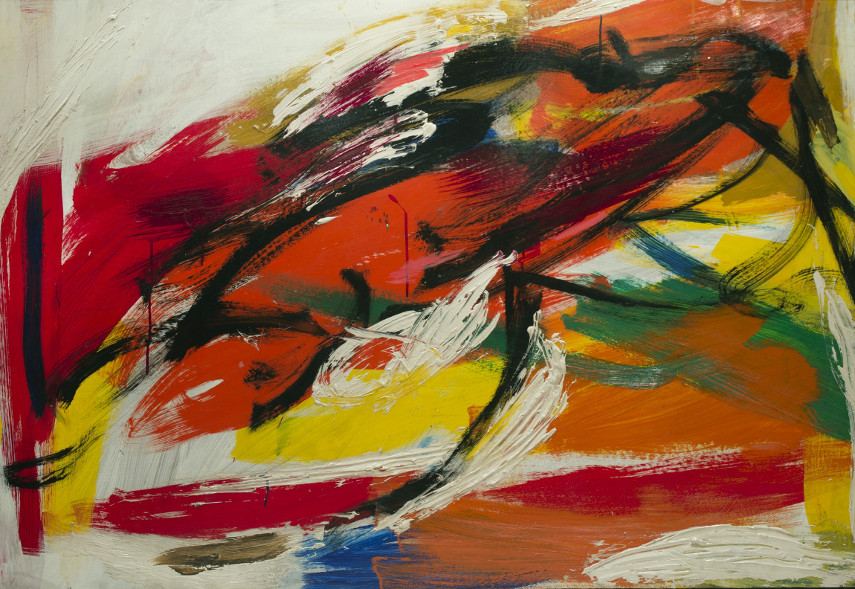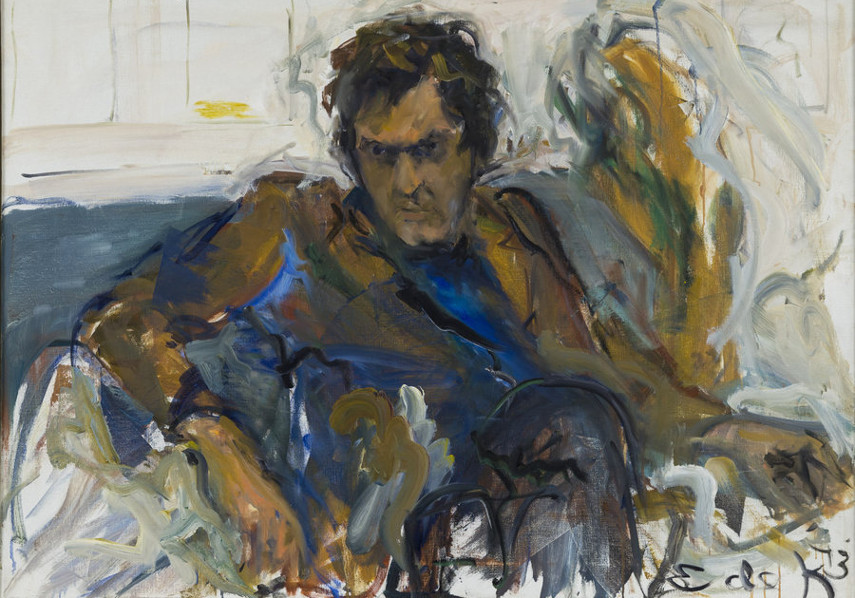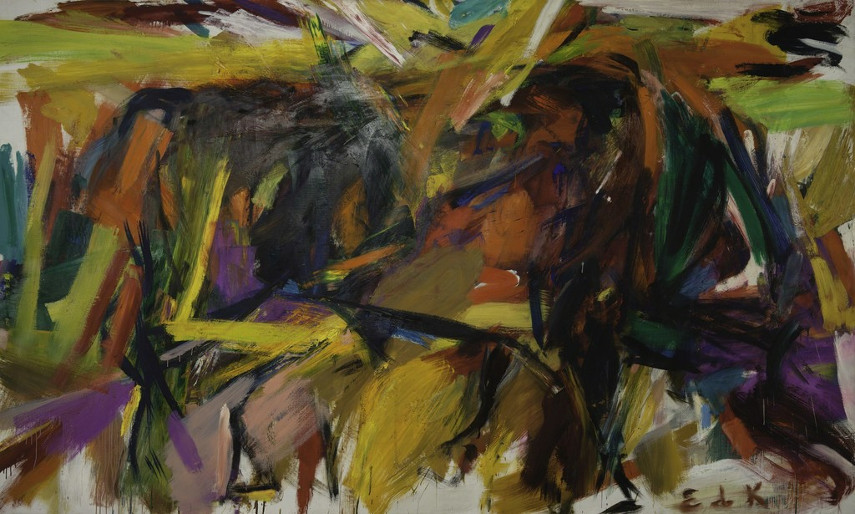Elaine De Kooning Georgia Artists Art Lesson for Kids
A major figure in both the Abstract Expressionist and American Figurative Expressionist movements of the 1940s and 1950s, Elaine de Kooning was a prominent American painter who can hands be classified as one of the virtually of import female artists of the 20th century[1]. She was a prolific and versatile painter, writer and teacher whose paintings featured loose and thick brushstrokes made in assuming hues and executed in an energetic, improvisational style. Although Elaine de Kooning was closely associated with the New York Schoolhouse and the famed Abstract Expressionism electric current, she worked difficult at developing a atypical, personal mode and painted in a wide array of modes ranging from realism to abstraction. Her original proper name was Elaine Marie Fried only she changed it later she married the legendary Willem de Kooning and took on his own family name[two].

Before Elaine Marie Fried Was Elaine de Kooning
Although she often claimed that she was born in 1920, Elaine Marie Fried was really born in the twelvemonth of 1918, in the Flatbush neighborhood of New York City. The eldest of 4 children, her parents were Mary Ellen O'Brien, an Irish Catholic, and Charles Frank Fried, a Protestant of Jewish descent. Elaine'south mother started taking her eldest child to museums at the age of five, teaching her to depict what she saw along the style. Mary Ellen O'Brien did accept some failings as a mother, but these early events shaped her daughter'due south future career. By the fourth dimension she was in form school, Elaine began drawing and selling portraits of children from her grade. Subsequently graduating from high school, Elaine Marie Fried briefly attended Hunter Higher in New York City where she befriended a grouping of abstract and Social Realist painters. In 1938, her teacher introduced her to Willem de Kooning at a Manhattan breakfast cafeteria - she was 20 and he was 34 years of age at the time. After that, he began to instruct her in drawing and painting, but their relationship was marked by his harsh criticism of her piece of work - Willem fifty-fifty destroyed many of her drawings while they were dating. The two married in 1943.

The Search for an Artistic Course
After coming together Willem, Elaine suddenly constitute herself within the circumvolve of the most prominent national artists in New York, spending time with the likes of Jackson Pollock, Jimmy Rosati, Giorgio Spavento, Milton Resnick, Pat Passlof, Earl Kerkam, Ludwig Sander, Angelo Ippolito, Franz Kline, Clyfford Notwithstanding and Hans Hofmann. She often exhibited her ain work alongside her married man's, very aware that it was usually overshadowed by Willem's fame. Although women were often marginalized in the Abstract Expressionist move, Elaine de Kooning never attempted to make some distance between herself and these painters. However, she did chose to sign her artworks with her initials rather than her full name to avoid labeling her fine art as feminine. She made both abstract and figurative paintings and drawings of all the same life, cityscapes and portraits - one of her most notable portraits was the 1 of the American president John Kennedy[3], probably the most famous abstract portrait of a Kennedy ever made. Elaine de Kooning fused brainchild with mythology, primitive imagery and realism, treating her art every bit an event beginning and simply secondarily equally an image, more than equally a verb and less as a noun. [four] She began working at the magazine Artnews in 1948 and wrote articles well-nigh major figures in the art world. Afterwards writing nigh one hundred manufactures on diverse topics, she became an art critic and was the first notable American artist in the 1950s to accept on this role.
Elaine de Kooning treated her painterly compositions more every bit tools of storytelling and conversations than a form of pure activeness fine art

Events of Her After Life
The marriage betwixt Elaine and Willem was full of affairs as both of them desired to have an open up relationship. Additionally, both of them struggled with alcoholism and that eventually led to their separation in 1957. Elaine remained in New York, struggling with poverty, and Willem moved to Long Island and dealt with low. They both continued painting[5]. She took on a series of curt-term pedagogy task to support herself - she fifty-fifty spent time at Black Mount College where she designed a stage fix for Merce Cunningham and John Cage. Although separated for nearly twenty years, Elaine and Willem never divorced and ultimately reunited in 1976 when the artist wanted to accept care of her sick husband. Elaine de Kooning died on the 1st of February in 1989, in Southampton, New York, a twelvemonth after having a lung removed due to cancer. Sadly, she did non receive real recognition for her own accomplishment until a few years before she died.
Following many recent discoveries and an increasing involvement in her work, Elaine de Kooning tin can now easily be described as one of the nigh versatile artists of the Abstract Expressionist movement

The Pivotal Part of Elaine de Kooning ( 1918–1989 )
Although it often seems as if Elaine Marie Fried is primarily known for her turbulent marriage with one of the greatest 20th-century modern painters, information technology's hard to overlook all of her contributions to the development of contemporary art. Her borderline stubborn rejection of dedicating herself to whatever i and only manner combined with the way she treated the painterly pieces every bit events easily secure Elaine de Kooning's place within any list of the great modern female person artists. Ultimately, Elaine's artistic range, vast knowledge of media and sheer influence on fellow artists was undeniable and it made it pretty hard for her career to stay completely overshadowed by that of Willem de Kooning. Present, she is widely accustomed equally a separate artist who not but worked on her own fashion independent from her husband's work but as well massively contributed to the development of Willem's concepts.
References:
Featured paradigm: Elaine de Kooning - Photo of the artist, 1960 - Image via Rudolph Burckhardt
All images used for illustrative purposes only.
Source: https://www.widewalls.ch/artists/elaine-de-kooning
0 Response to "Elaine De Kooning Georgia Artists Art Lesson for Kids"
Post a Comment